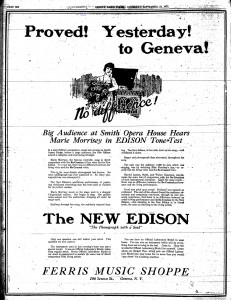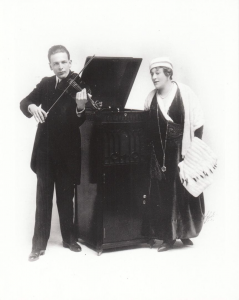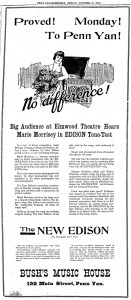SMITH HISTORY BLOG: The Edison Tone Test
by Austin Jennings

An advertisement for the “New” Edison Phonograph sold in Geneva at the Ferris Music Shoppe. It uses a description of the previous night’s event, the Edison Tone Test at the Smith Opera House, as a tool to sell the product (“Proved! Yesterday! to Geneva!”).
The Edison Tone Test, shown at The Smith in 1921, was a brilliant marketing strategy developed by the fabled Thomas Edison to sell his phonographs. Faced with skillful competitors like Victor and Columbia Records (“History of the Edison Disc Phonograph”), Edison was focused on making the quality of the records he produced as high as possible. At this time, in the first couple decades of the 20th Century, “the major phonograph companies […] sold both the talking machines and the records to play on them” (Degraaf 110). This meant that Edison was tailoring both his phonographs and records to his own technical standards. Even though he thought that’s what consumers needed, Edison’s sales struggled because of the public’s indifference to sound quality. As a response, Edison decided to change his marketing tactic from telling people his products had a superior quality, to showing them.
At first, in 1910, Edison began this new marketing approach by sending out horse-drawn carriages full of his products. His employees would go door-to-door and allow customers a free trial of the phonograph and records, with the promise that they would be back to either sell or take back the machine (Degraaf 114). Five years later, Edison escalated this “show-don’t-tell” method with the introduction of the Tone Test. It consisted of a live performance by a singer or instrumentalist onstage with an Edison phonograph. The singer or instrumentalists’ performance was pre-recorded so that the human and the machine could alternate playing, challenging audiences to hear a difference between the two (“History of the Edison Disc Phonograph”). Before this, “no phonograph manufacturer had dared to take the dramatic, theatrical chance of placing a live opera star beside a functioning phonograph” (Baldwin 337). It may have been risky for Edison to have tested his products so rigorously in front of live audiences, but it certainly paid off. He saw a dramatic increase in revenue because of the Tone Tests, which were implemented nationwide (Baldwin 339).

A picture, taken in 1918, of two of the most famous Edison Tone Test musicians, Albert Spalding and Marie Rappold, performing with an Edison phonograph as part of a Tone Test (“Edison Phonograph Tone Test”).
The Tone Test at the Smith Opera House is proof that it was a successful marketing strategy, since it occurred six years after the first ones. Thus, it became Edison’s repeatable and reliable method to sell phonographs. His phonograph company employed a group of musicians not only to record and sell records, but also to perform in the Tone Tests (Baldwin 338-339). It can be assumed that Marie Morrisey, a nationally renowned contralto, was the musician employed by the company to perform in New York State. She performed an Edison Tone Test at the Smith as well as ones before and after that in Albany and Penn Yan respectively (“and no one could tell the difference;” “Proved! Monday! To Penn Yan;” “Proved! Yesterday! to Geneva!”). The subsequent ads for these tests, shown here, sensationalized the events, boasting large turnouts and convinced audiences. Their obvious bias obscures what the audience at the Smith truly thought of the Edison phonograph. Although, since Morrisey gave a private Tone Test years later when she returned to see friends in Geneva (“Kiwanis Club Hears Marie Morrisey Sing”), it’s quite possible the audience was about as enthralled as the ad would lead us to believe.
Over the past few years, there has been a rumor that Thomas Edison himself showed off his phonograph at the Smith Opera House. Unfortunately, that is most likely false. Edison’s appearance in Geneva certainly would have made headlines in the local newspapers, but no such historical articles have been found to date. The rumor therefore probably arose with a miscommunication about the Tone Test performance. We should not feel too disappointed, however. The Smith Opera House Tone Test is still a fascinating moment in Geneva’s history which should be remembered and celebrated. It is an important mark in the technological and marketing developments of American history, and it is exciting that our own neighborhood opera house was a part of it.

An advertisement for the “New” Edison Phonograph, which describes the previous night’s event, the Edison Tone Test at the Elmwood Theatre. This Tone Test occurred a year after the one at the Smith (“Proved! Monday! To Penn Yan!”).
Works Cited
Baldwin, Neil. Edison: Inventing the Century. Hyperion, 1995.
DeGraaf, Leonard. Edison and the Rise of Innovation. Sterling Signature, 2013.
“Edison Phonograph Tone Test.” https://www.worthpoint.com/worthopedia/edison-phonograph-tone-test-albert-1872128243
“History of the Edison Disc Phonograph.” Library of Congress, “Inventing Entertainment: The Early Motion Pictures and Sound Recordings of the Edison Companies” collection, https://www.loc.gov/collections/edison-company-motion-pictures-and-sound-recordings/articles-and-essays/history-of-edison-sound-recordings/history-of-the-edison-disc-phonograph/.
“Kiwanis Club Hears Marie Morrisey Sing.” Geneva Daily Times, 29 Oct 1922. Rochester Regional Library Council. NYS Historic Newspapers.
“Proved! Monday! To Penn Yan!” Penn Yan Democrat, 27 Oct 1922. Rochester Regional Library Council. NYS Historic Newspapers.
“Proved! Yesterday! to Geneva!” Geneva Daily Times, 29 Sept 1921. Rochester Regional Library Council. NYS Historic Newspapers.